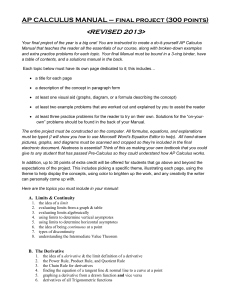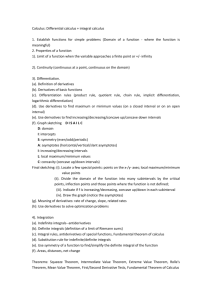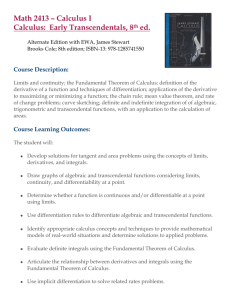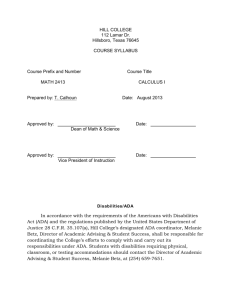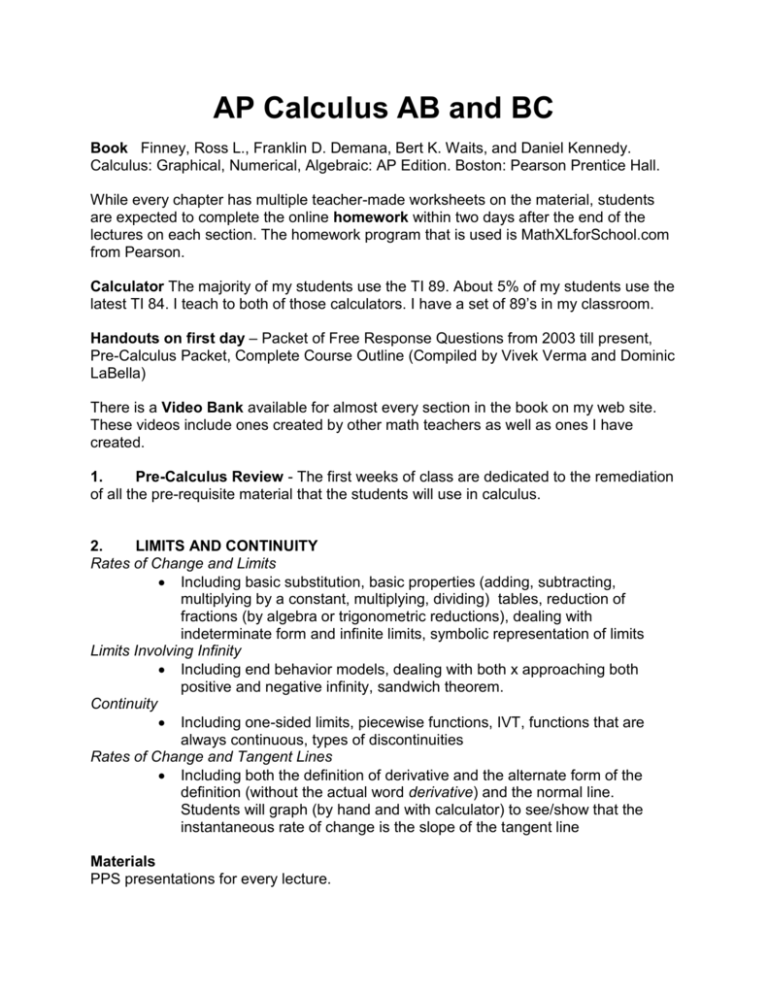
AP Calculus AB and BC
Book Finney, Ross L., Franklin D. Demana, Bert K. Waits, and Daniel Kennedy.
Calculus: Graphical, Numerical, Algebraic: AP Edition. Boston: Pearson Prentice Hall.
While every chapter has multiple teacher-made worksheets on the material, students
are expected to complete the online homework within two days after the end of the
lectures on each section. The homework program that is used is MathXLforSchool.com
from Pearson.
Calculator The majority of my students use the TI 89. About 5% of my students use the
latest TI 84. I teach to both of those calculators. I have a set of 89’s in my classroom.
Handouts on first day – Packet of Free Response Questions from 2003 till present,
Pre-Calculus Packet, Complete Course Outline (Compiled by Vivek Verma and Dominic
LaBella)
There is a Video Bank available for almost every section in the book on my web site.
These videos include ones created by other math teachers as well as ones I have
created.
1.
Pre-Calculus Review - The first weeks of class are dedicated to the remediation
of all the pre-requisite material that the students will use in calculus.
2.
LIMITS AND CONTINUITY
Rates of Change and Limits
Including basic substitution, basic properties (adding, subtracting,
multiplying by a constant, multiplying, dividing) tables, reduction of
fractions (by algebra or trigonometric reductions), dealing with
indeterminate form and infinite limits, symbolic representation of limits
Limits Involving Infinity
Including end behavior models, dealing with both x approaching both
positive and negative infinity, sandwich theorem.
Continuity
Including one-sided limits, piecewise functions, IVT, functions that are
always continuous, types of discontinuities
Rates of Change and Tangent Lines
Including both the definition of derivative and the alternate form of the
definition (without the actual word derivative) and the normal line.
Students will graph (by hand and with calculator) to see/show that the
instantaneous rate of change is the slope of the tangent line
Materials
PPS presentations for every lecture.
The following worksheets: Sandwich Theorem / Limits involving infinity; Algebra and the
Limit, and The Everything That You Could Possibly Be Asked About Limits In Chapter 2
Worksheet.
Evaluations
Quick Quiz on one-sided limits, Quick quiz on memorized theorems (Sandwich and IVT)
with uses of each. Jeopardy Quiz (A graph is drawn and students are asked, “In terms
of the three conditions of continuity, what was the student asked to draw?”). Homework
on each section (MathXLforSchool.com). Chapter Test on all of limits.
3.
DERIVATIVES
Derivative of a Function
Including definition of derivative; alternate definition of derivative; symbols
used to represent derivatives, average rate of change vs. instantaneous
rate of change
Differentiability
Including the connection between derivatives and continuity, where
derivatives don’t exist, graphing derivatives and finding derivatives on the
home screen of the calculator, symmetric difference quotient. Brief
covering of horizontal asymptotes connected to max’s / min’s and the
increasing function means a positive slope of the tangent line.
Rules for Differentiation
The shortcuts, notation for higher order derivatives
Velocity and Other Rates of Change
Including how long particles are in the air, when does a particle hit the
ground, position of the particle when velocity equals a value.
Derivatives of Trigonometric Functions
Chain Rule
Implicit Differentiation
Including derivatives of inverses of functions
Derivatives of Inverse Trigonometric Functions
Derivatives of Exponential and Logarithmic Functions
Including logarithmic differentiation, derivatives of logs / lns, exponentials.
* In this chapter, students will show that they understand derivatives by computing them
and also by graphing f’(x) and f”(x) when given a drawing of f(x). Students are expected
to use their calculators to graph derivatives and to use their home screens to find
derivatives (including implicit d).
Materials
PPS presentations on each section. Worksheet “The Long Way” (finding derivatives
using the definition, alternate definition, and the symmetric difference quotient), “The
Pain of Algebra” (Reducing derivatives after using the product / quotient rules). The
answers to the problems must match the answers that the students get when they use
their calculators. Discovery worksheet for the derivatives of inverses of functions,
worksheet on difficult implicit d questions, Worksheet at the end of the chapter that has
difficult chain rule combined with exponential / logarithmic problems.
Evaluations
Small quizzes on memorized derivatives. Cumulative quiz on memorized theorems with
one application of each theorem. Students must get a perfect on this quiz for it to count.
Test on entire chapter.
4.
APPLICATIONS OF DERIVATIVES
Extreme Values of Functions
Including finding cp’s / max’s / min’s. Increasing / Decreasing. Setting up
sign charts / using mathematical notation to describe inc/dec.
Mean Value Theorem
Including the lecture of the myth of the EZ Pass tickets, graphically and
algebraically find c value that meets standards. This section also includes
Rolles Theorem.
Connecting y’ and y” with the graph of y
Including 2nd derivative sign charts, concavity, graphing 1st and 2nd
derivatives, graphing original equation from derivative information. This
section also includes speed / finding whether speed is increasing or
decreasing using 1st and 2nd derivatives. Finding max / min velocity,
acceleration, speed.
Modeling and Optimization
Including Popcorn box example (Students in groups are given different
sizes of paper and they create their own boxes. They want the largest box
possible because they get to fill it with popcorn). They have to graphically
represent their model.
Linearization and Newton's Method
(While Newton’s method isn’t on the AP test, it is an interesting kick-off to
show value of the tangent line) Including tangent lines and differential
equations. This section also has beginning antidifferentiation with the
concept of the family of antiderivatives
Related Rates
Including problems using proportions and all manner of shapes changing
as time changes.
Materials
PPS presentations on each section. Worksheet after 3rd section with difficult example
that can only be done using the calculator. Popcorn box materials (paper / scissors /
tape / popcorn / a broom…). Worksheet on Newton’s method. Worksheet with 40
additional real world related rates problems, worksheet called “Volpe goofs” with APstyle questions and answers that are not acceptable. Students have to determine why
the work shown / answers given are wrong. Students will use the packet of former AP
questions starting in this chapter to see AP-style related rates multi-part problems.
Evaluations
Test on entire chapter 4. Cumulative quiz on memorized theorems with one application
of each theorem. Students must get a perfect on this quiz for it to count.
Starting with this chapter, students will have “quests” two days after the test on material
from two chapters ago (so this quest will be on limits)
5.
THE DEFINITE INTEGRAL
Estimating with Finite Sums
Including RRAM, LRAM, MRAM, using charts, equations, and graphs,
Students are required to find a calculator program that will find RAMs.
Students will learn over-estimating / underestimating using 2nd derivative.
Students will inscribe and circumscribe rectangles.
Definite Integrals
Including the connection between an infinite number of rectangles and the
integral.
Definite Integrals and Antiderivatives
Including all basic antidifferenitaion rules. Average Value / Mean Value
Theorem for Integrals, and finding the x value associated with the MVT
both algebraically and graphically. Finding distance traveled as the
integral of velocity. Finding average velocity using MVT
Fundamental Theorem of Calculus Pts. 1 and 2
Including both the derivative of the integral (and the integral of the
derivative) and the Integral Evaluation Theorem. Finding tangent lines
when given the function as an integal
Trapezoidal Rule
Materials
PPS presentations on each section. Worksheet to kick off the chapter on rectangles and
trapezoids. (I have them drawn. The kids have to find the areas under the curves using
the shapes that I have drawn. Students must create a table to model the graphs /
geometric shapes I have made), worksheet on FTC with variable in both limits of
integration, worksheet on some basic integrals. Multiple problems from Free Response
Packet.
Evaluations
Cumulative quiz on memorized theorems with one application of each theorem.
Students will demonstrate that they understand when a function meets the necessary
requirements for a theorem to hold. Students must get a perfect on this quiz for it to
count. Test on all of 5; Quest on Chapter 3
The December break usually happens mid-Chapter 5 for AB – There is a pack of
multiple choice AP problems that are due two days after we return from break.
The Pennsylvania required Student Learner Objectives (SLOs) for AB will take
place after Chapter 5.
Part 1 –Students are expected to get a 90% or above on the Chapter 3 Quest.
Part 2 – Students will be given a worksheet with a table of x’s and their associated y’s.
Students will answer a variety of questions on the derivative
6.
DIFFERENTIAL EQUATIONS AND MATHEMATICAL MODELING
Slope Fields and Euler's Method
Including creating slopefields by hand and on their 89s. Students are
required to get a calculator program (that is easier to use than the one
built into the calculator). This is a flipped lesson. Students must watch the
video that I have created online before they come to class. Students must
be able to sketch a graph given initial conditions and “connecting” the
slopes on the slopefield.
Antidifferentiation by Substitution
Antidifferentiation by Parts
This is a flipped lesson. Students must watch two videos before coming to
class.
Exponential Growth and Decay
Logistic Growth
Including analysis of differential equations / solving differential equations
with initial conditions and domain restrictions. Using logistic growth
models.
Material that we cover that is not (officially) in book
Antidifferentiation of trig functions to different powers
Antidifferentiation by trig substitution
Materials
PPS presentations on each section. Packet of material for the “Not in book” material
above.
In our school, one of the rites of passage is “The Integral Packet.” Both AB and BC
students learn all of the methods above even though not all are required for AB.
Students get 70-80 integrals (depending on the luck of the draw for their year – I have
multiple versions of this assignment). Every integral requires at least two of the types of
integration that they learned for each problem. We spend ten days in AB and eight in
BC working on these packets in class. Students are required to use their calculators to
show that their answers are correct (either on the home screen or by using the grapher).
Technology stronger than their calculator is frowned upon. Students must get a 52/104
or higher on the test to have their packet accepted. Students with grades lower than that
must start the whole process over again without using class time.
Evaluations
Test on all of 6. Students must get 75% on the integral packet to have the assignment
count as 100/100.
Quest on Chapter 4
The December break usually happens mid-Chapter 5 for BC – There is a pack of
multiple choice AP problems that are due two days after we return from break.
7.
APPLICATIONS OF DEFINITE INTEGRALS
Integral as Net Change
Including total distance traveled, displacement. Using the initial condition
to find the particle’s position.
Areas in the Plane
Area between curves using geometry and integration.
Volumes (Disks, Washers, Shells and Cross Sections)
Lengths of Curves
Materials
PPS presentations on each section that include numerous computer-generated
presentations of revolutions of planes around lines. Worksheet on sketching the initial
planar regions that are the start of numerous 3 dimensional figures / finding the volumes
of these figures by one of the methods described in the chapter. Worksheet on finding
lengths of curves first by “guessing” by analyzing the graph, then by using analytical
methods.
Evaluations
Test on all of Chapter 7. Quest on 5.
8.
SEQUENCES, L'HÔPITAL'S RULE, AND IMPROPER INTEGRALS (BC only
material in blue)
Sequences
Defining convergence / divergence in terms of sequences.
L'Hôpital's Rule
Including how to handle indeterminate forms
Relative Rates of Growth
Improper Integrals
Materials
PPS presentations on each section. Worksheet on examining graphs and equations to
determine where an integral would be considered improper. Worksheet on graphically
and algebraically (with limits) determining which function grows faster.
Evaluations
Quiz for AB on L'Hôpital's Rule and growth rates. Test for BC on all of Chapter 8.
9.
INFINITE SERIES
Power Series
Including introductory worksheet with a calculator exploration on why we
need series. Geometric Series. Telegraphing Series. Finding sums of
series. Determining convergence / divergence in terms of series. What
“centered” means in terms of series.
Taylor Series
Including construction of series and the common Maclaurin Series / the
manipulation of these Maclaurin Series. Beginning integration with series.
Taylor's Theorem
Including finding error using LaGrange and number of terms needed to
control error using the calculator
Radius and Beginning Interval of Convergence
Including ratio and nth root tests.
Testing Convergence at Endpoints
This section contains the brunt of the chapter. Alternating series. Error
bound with Alternating Series. Harmonic Series. P-Series. Integral test.
Absolute vs. Conditional convergence. Limit comparison tests. Direct
comparison test.
Materials
PPS presentations on each section. Multiple worksheets on the different concepts,
Multiple problems from Free Response Packet.
Evaluations
Quiz on memorized Maclaurin Series (with domains). Group project at the end with
multiple series questions. Exam on all of Chapter 9.
The Pennsylvania required SLOs for BC will take place after the Maclaurin Series
is taught.
Part 1 – (Aforementioned) Memorized Quiz on Maclaurin Series (Students required to
get 42/42 on this assessment)
Part 2 – Take home assignment on Maclaurin Series with mulitple problems using
Maclaurin (Example: Re-write sin(x2) using the appropriate Maclaurin Series and
integrate)
10.
PARAMETRIC, VECTOR, AND POLAR FUNCTIONS
This is a student driven chapter.
Students are placed in three groups. They must create two videos – One to explain the
pre-calculus behind their assigned section and one to describe the calculus involved
with their assigned material. Each student must present in the video. Each group must
provide videos created by other sources (PatrickJMT, Kahn, et al) and worksheets.
Each group must provide a former free response problem with answers available.
Students must earn a 90% or above on their own material before their section can be
posted for the others in class to view.
I wait till after presentations and use remediation as needed.
Parametric Functions
Including finding the first and second derivatives, finding tangent lines,
finding speed, length of curve / total distance traveled.
Vectors in the Plane
Including finding the velocity and acceleration vectors, speed, distance
traveled / position of the particle given velocity.
Polar Functions
Including finding the slope (dy/dy), areas enclosed by graphs, area
between two polar curves
Materials
Access to computer carts. Access to microphone for kids-recorded videos.
Evaluations
Quizzes for each section (for students to prove that they know their own material before
they go on to teach the others in class). Student-produced homework / worksheets. Test
on all of Chapter 10.
AP Review
Once the new material ends, we begin the review. The calendar has different exercises each day.
Students do approximately 500 multiple choice questions before the AP test. They are given a list on
the first day of the review and each student knows which question s/he is to be an expert. They then
fill in “Signature sheets.” For example – I cannot figure out how to do problem number 6 on Day 5 of
the material. I will get credit for showing the teacher that I tried to do the problem, but during class, I
must find the student in charge of problem number 6. That person has to explain it to me in a way that
I can understand and sign off on my paper that I proved that I understand. While I am getting
signatures for the ones that I do not know, people are also coming to me to get help on the questions
that are considered to be mine.
We did / do about half of the free response questions that have been given since 2003 during class.
In the first few days of the review, we look at some of the posted responses that other students have
given. There are two after-school review sessions, and one Sunday morning session where we do
some of the alternate exams. These are driven by the students who determine where they are
weakest.
The Friday before the exam, students can stay after school to do a compressed version (2 hours –
each section is dramatically shortened) of the AP test using one of the super-secret tests that the
CollegeBoard has online. I score these and send the predicted AP score to the students on Saturday.
Days that we get a little off-topic… but we are still concentrating on calculus.
There are a few days that we get off topic in class.
1. We will watch a movie in the two days before Thanksgiving break. Stand and Deliver.
2. In the two days before the December holiday break, we sometimes play a game that I have
created called Calculopoly. Do not let the word “game” fool you. It is constant calculus while
moving ahead on the board.
3. To kick off the first calculus chapter, we have a brief day to have a history lesson on what was
going on in the world during the advent of calculus. While I do throw in lessons on Rolles and
Newton during the regular lectures, this lecture is about 30 minutes of a full 42 minute class.
Snow Days!
Snow Days are chock full of calculus. Students must check their email in the morning to find out what
they need to do for class.
This course provides students with the opportunity to work with functions represented in a variety of
ways -- graphically, numerically, analytically, and verbally -- and emphasizes the connections among
these representations.
This course teaches students how to use graphing calculators to help solve problems, experiment,
interpret results, and support conclusions.
This course teaches students how to communicate mathematics and explain solutions to problems
both verbally and in written sentences.


